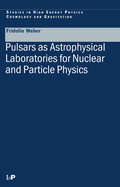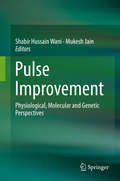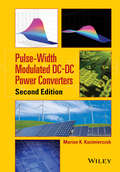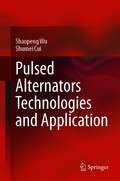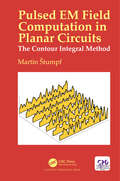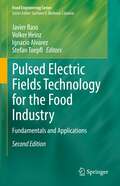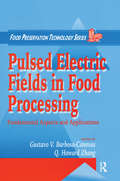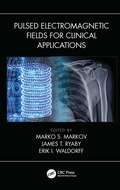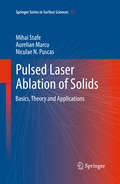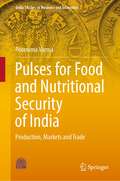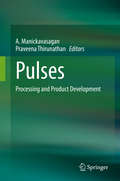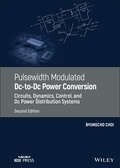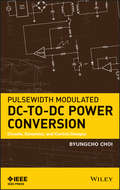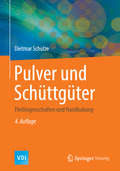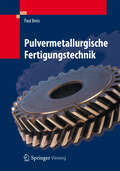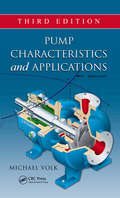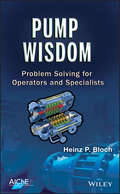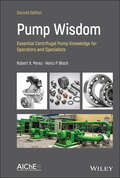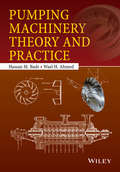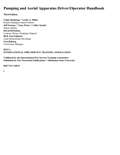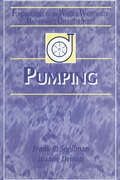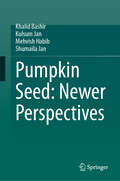- Table View
- List View
Pulsars as Astrophysical Laboratories for Nuclear and Particle Physics (Series in High Energy Physics, Cosmology and Gravitation)
by Fridolin WeberPulsars, generally accepted to be rotating neutron stars, are dense, neutron-packed remnants of massive stars that blew apart in supernova explosions. They are typically about 10 kilometers across and spin rapidly, often making several hundred rotations per second. Depending on star mass, gravity compresses the matter in the cores of pulsars up to more than ten times the density of ordinary atomic nuclei, thus providing a high-pressure environment in which numerous particle processes, from hyperon population to quark deconfinement to the formation of Boson condensates, may compete with each other. There are theoretical suggestions of even more ""exotic"" processes inside pulsars, such as the formation of absolutely stable strange quark matter, a configuration of matter even more stable than the most stable atomic nucleus, ^T56Fe. In the latter event, pulsars would be largely composed of pure quark matter, eventually enveloped in nuclear crust matter.These features combined with the tremendous recent progress in observational radio and x-ray astronomy make pulsars nearly ideal probes for a wide range of physical studies, complementing the quest of the behavior of superdense matter in terrestrial collider experiments. Written by an eminent author, Pulsars as Astrophysical Laboratories for Nuclear and Particle Physics gives a reliable account of the present status of such research, which naturally is to be performed at the interface between nuclear physics, particle physics, and Einstein's theory of relativity.
Pulse Current Gas Metal Arc Welding
by Prakriti Kumar GhoshThis monograph is a first-of-its-kind compilation on high deposition pulse current GMAW process. The nine chapters of this monograph may serve as a comprehensive knowledge tool to use advanced welding engineering in prospective applications. The contents of this book will prove useful to the shop floor welding engineer in handling this otherwise critical welding process with confidence. It will also serve to inspire researchers to think critically on more versatile applications of the unique nature of pulse current in GMAW process to develop cutting edge welding technology.
Pulse Improvement: Physiological, Molecular and Genetic Perspectives
by Shabir Hussain Wani Mukesh JainAdvances in molecular biology and genome research in the form of molecular breeding and genetic engineering put forward innovative prospects for improving productivity of many pulses crops. Pathways have been discovered, which include regulatory elements that modulate stress responses (e.g., transcription factors and protein kinases) and functional genes, which guard the cells (e.g., enzymes for generating protective metabolites and proteins). In addition, numerous quantitative trait loci (QTLs) associated with elevated stress tolerance have been cloned, resulting in the detection of critical genes for stress tolerance. Together these networks can be used to enhance stress tolerance in pulses. This book summarizes recent advances in pulse research for increasing productivity, improving biotic and abiotic stress tolerance, and enhancing nutritional quality.
Pulse-Jet Filtration: Part 1: Theory, Selection and Design of Pulse-Jet Filter
by Arunangshu MukhopadhyayThis book provides the fundamental concept of design and development of pulse-jet filters under varied situations. It discusses technical and commercial solutions for successful operation of textile industries integrated with pollution control equipment maintaining clean air requirements.
Pulse-Width Modulated DC-DC Power Converters
by Marian K. KazimierczukThis book studies switch-mode power supplies (SMPS) in great detail. This type of converter changes an unregulated DC voltage into a high-frequency pulse-width modulated (PWM) voltage controlled by varying the duty cycle, then changes the PWM AC voltage to a regulated DC voltage at a high efficiency by rectification and filtering. Used to supply electronic circuits, this converter saves energy and space in the overall system. With concept-orientated explanations, this book offers state-of-the-art SMPS technology and promotes an understanding of the principle operations of PWM converters, as well as enabling the readers to evaluate their characteristics. Design-orientated analysis (including a steady-state analysis for both continuous and discontinuous conduction modes) and numerous real-world practical examples (including circuit models of the PWM converters) demonstrate how to design these from scratch. The book provides an in-depth presentation of topologies of PWM DC-DC power converters, voltage- and current-mode control of PWM DC DC power converters, considers power losses in all components, device stresses, output voltage ripple, converter efficiency and power factor correction (PFC). It also includes extensive coverage of the following: topologies of high-efficiency switching-mode PWM and soft-switching DC-DC power converters; DC voltage transfer functions (conversion ratios), component values, losses, efficiency, and stresses; small-signal averaged circuit models; current-mode and voltage-mode feedback controls; metal-oxide-semiconductor field-effect power transistors (MOSFETs); silicon (Si) and silicon carbide (SiC) power semiconductor devices. Before now, there has been no book that covers silicon carbide devices. Pulse-width Modulated DC-DC Power Converters is a comprehensive textbook for senior undergraduate and graduate students in the areas of electrical, electronics, and telecommunications engineering. It includes end-of-chapter review questions, problems, and thorough summaries of the key concepts to aid learning, and a Solutions Manual is available for professors. Scientists and practicing design engineers working with SMPS, within such applications as computers, telecommunications, industrial systems, automobile electronics, medical equipment, aerospace power technology, and radars (amongst others) will also find this text insightful.
Pulsed Alternators Technologies and Application
by Shumei Cui Shaopeng WuThis book focuses on pulsed alternators design and applications. Both principles and design methods have been addressed. This is achieved by providing in-depth study on a number of major topics such as electrical design, thermal management, mechanical analysis, and special application. The research results and practical experience accumulated in the preliminary research, the National Natural Science Foundation of China and other major cooperative projects. Taking the pulse alternator as the core component, the entire pulse alternator system is systematically introduced, including the electromagnetic design, thermal management analysis, mechanical performance analysis of the pulse alternator, the introduction of the electromagnetic weapon load, the control technology of the pulse alternator power system, and the elaboration of other key components of the power system. This motor has been researched at home and abroad, but this book is the first international monograph on the field of pulse alternators in this field, which has very important academic value and reference value. The book benefits researchers, engineers, and graduate students in fields of electrical engineering, pulsed power, etc.
Pulsed EM Field Computation in Planar Circuits: The Contour Integral Method
by Martin StumpfThe pulsed EM characterization of planar circuits is of high practical importance in many areas of science and engineering such as electromagnetic compatibility and antenna design. This book is hence devoted to the mathematical formulation and numerical analysis of arbitrarily-shaped parallel-plane structures concerning their pulsed EM propagation, radiation and scattering behavior. The key emphasis is on the time-domain reciprocity-based integral-equation formulations and their efficient numerical solution.
Pulsed Electric Fields Technology for the Food Industry: Fundamentals and Applications (Food Engineering Series)
by Volker Heinz Javier Raso Ignacio Alvarez Stefan ToepflMany novel technologies have been proposed in the attempt to improve existing food processing methods. Among emerging nonthermal technologies, high intensity pulsed electric fields (PEF) is appealing due to its short treatment times and reduced heating effects. This book presents information accumulated on PEF during the last 15 years by experienced microbiologists, biochemists, food technologists, and electrical and food engineers.
Pulsed Electric Fields in Food Processing: Fundamental Aspects and Applications (Food Preservation Technology)
by Q. Howard Zhang Gustavo V. Barbosa-CanovasPulsed Electric Fields (PEF) is one of the nonthermal processing approaches that is receiving considerable attention by scientists, government and the food industry as a potential technique to be fully adopted to process foods at the industrial level. PEF presents a number of advantages including minimal changes to fresh foods, inactivation of a wi
Pulsed Electrical Discharges for Medicine and Biology
by Victor Kolikov Philip RutbergThis book presents the application of pulsed electrical discharges in water and water dispersions of metal nanoparticles in medicine (surgery, dentistry, and oncology), biology and ecology. The intensive electrical and shock waves represent a novel technique to destroy viruses and this way to prepare anti-virus vaccines. The method of pulsed electrical discharges in water allows to decontaminate water from almost all known bacteria and spores of fungi being present in human beings. The nanoparticles used are not genotoxic and mutagenic. This book is useful for researchers and graduate students.
Pulsed Electromagnetic Fields for Clinical Applications
by Marko S. Markov James T. Ryaby Erik I. WaldorffPulsed Electromagnetic Fields for Clinical Applications presents the historical development, the state of art, and the future of the application of pulsed electromagnetic fields (PEMFs) for the treatment of various medical problems, including initiating various healing processes from delayed fractures and pain relief to multiple sclerosis and Parkinson’s disease. The emphasis is on the development of scientific methods to be implemented in clinical application. In perspective, this modality provides a practical, exogenous method for inducing cell and tissue modification attempted to the injured tissues to their normal physiological status. The book reviews the current state of equipment for PEMFs and highlights worldwide therapeutic achievements. It explores the past, present, and future of PEMF therapies. It presents the development of theory and laboratory research during the last 70 years. It reviews the available equipment for PEMF. It reviews the state of the art of worldwide therapeutic achievements. It includes recent achievements and applications of electroporation modalities.
Pulsed Laser Ablation of Solids
by Mihai Stafe Aurelian Marcu Niculae N. PuscasThe book introduces 'the state of the art' of pulsed laser ablation and its applications. It is based on recent theoretical and experimental studies. The book reaches from the basics to advanced topics of pulsed laser ablation. Theoretical and experimental fundamental phenomena involved in pulsed laser ablation are discussed with respect to material properties, laser wavelength, fluence and intensity regime of the light absorbed linearly or non-linearly in the target material. The energy absorbed by the electrons leads to atom/molecule excitation, ionization and/or direct chemical bond breaking and is also transferred to the lattice leading to material heating and phase transitions. Experimental non-invasive optical methods for analyzing these phenomena in real time are described. Theoretical models for pulsed laser ablation and phase transitions induced by laser beams and laser-vapour/plasma interaction during the plume expansion above the target are also presented. Calculations of the ablation speed and dimensions of the ablated micro- and nano-structures are performed. The validity and required refinement of different models in different experimental conditions is provided. The pulsed laser deposition process which bases on collecting the ablated particles on a surface is analyzed in terms of efficiency and quality of the deposited films as a function of ambient conditions, target material, laser parameters and substrate characteristics. The interaction between the incident laser and the ablation plasma is analyzed with respect to its influence on the structures of the deposited films and its capacity to generate high harmonics and single attosecond pulses which are highly desirable in pump-probe experiments.
Pulses for Food and Nutritional Security of India: Production, Markets and Trade (India Studies in Business and Economics)
by Poornima VarmaThis book provides an in-depth analysis of India’s pulses sector in terms of production, prices, markets, and trade. Pulses play a pivotal role in a developing country like India for all categories of people due to its rich protein content (double that of wheat and three times more than that of rice). Despite being an important crop from the point of view of food, nutrition, and environmental security, the focus of food security policies in developing countries has been more on wheat and rice production. This book analyses factors influencing the supply of pulses with a greater emphasis on government interventions such as minimum support price (MSP) and National Food Security Mission (NFSM), the effectiveness of MSP and factors influencing farmers’ access to MSP, the import dependency implications through a detailed import pricing behavior of major importers of major pulses. It investigates production, market dynamics, and trade implications related to two major pulses, chickpea and pigeonpea, produced by all pulse-producing States in India. Analysis of farmer's awareness of MSP and factors influencing access to MSP are undertaken through a comprehensive household survey from the States of Maharashtra, Karnataka, and Madhya Pradesh. Finally, the book analyses import implications and import pricing behaviour for all major pulses imported by India. The book would be very useful for researchers working on the issues of agricultural production and food security, for agriculture and agri-business students, as well as for policy makers to understand the inherent dynamics in the pulses sector.
Pulses: Processing and Product Development
by A. Manickavasagan Praveena ThirunathanWorld health authorities recommend people maximize their protein intake through vegetable sources (such as pulses), and reduce protein intake from animal sources. Increasing vegetable protein intake has been shown to be positively associated with the reduction of both cardiovascular-disease-related mortality and all-cause mortality. Pulse consumption has been shown to improve satiety and metabolism of glucose and lipids, due to their high protein and fiber content, which makes their consumption ideal for preventing and managing obesity. In recent years, there has been increasing demand for pulses and pulse-based products in developed countries. Several large-scale collaborative research projects on pulse products have been initiated by government agencies. Similarly, established multinational food companies have developed pulse product units. Pulses: Processing and Product Development fulfills the need for a comprehensive book on processing and products of pulses. The book addresses a specific pulse with each chapter to meet a wide range of audiences from undergraduate students to consumers.
Pulsewidth Modulated DC-to-DC Power Conversion: Circuits, Dynamics, Control, and DC Power Distribution Systems
by Byungcho ChoiExplore a fully updated reference for professional and student engineers working with pulsewidth modulated DC-to-DC power conversion The newly revised Second Edition of Pulsewidth Modulated DC-to-DC Power Conversion: Circuits, Dynamics, and Control Designs delivers a comprehensive exploration of pulsewidth modulated DC-to-DC converters for analysis and design as standalone converters and as an interconnected system. The book begins with discussions of the circuits, dynamics, and control of standalone PWM converters before moving on to examine the dynamic analysis and system design of DC power distribution systems. The distinguished authors balance theory with the practical aspects of DC-to-DC power conversion based on classical linear system theory. They include new information on the generalization of power stage modeling, the Nyquist criterion, and universal small-signal models for PWM DC-to-DC converters. The book also includes supplemental material, like a solutions manual, lecture slides, and PSpice source codes for over 250 PSpice programs for illustrative simulations. Readers will also benefit from the inclusion of: A thorough introduction to PWM DC-to-DC power conversion, power stage components, and buck converters An exploration of DC-to-DC power converter circuits, including boost converters, three basic converters, and flyback converters Discussions of the modeling and dynamics of PWM converters, including power stage transfer functions and the dynamic performance of PWM DC-to-DC converters An examination of control schemes and converter performance, including closed-loop performance and feedback compensation Perfect for senior undergraduate students in departments of electrical engineering or electronics, Pulsewidth Modulated DC-to-DC Power Conversion will also earn a place in the libraries of graduate students and practitioners of power electronics or electrical energy conversions, as well as analog/digital circuit engineers.
Pulsewidth Modulated DC-to-DC Power Conversion: Circuits, Dynamics, and Control Designs (Ieee Press Series On Power Engineering Ser.)
by Byungcho ChoiThis is the definitive reference for anyone involved in pulsewidth modulated DC-to-DC power conversion Pulsewidth Modulated DC-to-DC Power Conversion: Circuits, Dynamics, and Control Designs provides engineers, researchers, and students in the power electronics field with comprehensive and complete guidance to understanding pulsewidth modulated (PWM) DC-to-DC power converters. Presented in three parts, the book addresses the circuitry and operation of PWM DC-to-DC converters and their dynamic characteristics, along with in-depth discussions of control design of PWM DC-to-DC converters. Topics include: Basics of DC-to-DC power conversion DC-to-DC converter circuits Dynamic modeling Power stage dynamics Closed-loop performance Voltage mode control and feedback design Current mode control and compensation design Sampling effects of current mode control Featuring fully tested problems and simulation examples as well as downloadable lecture slides and ready-to-run PSpice programs, Pulsewidth Modulated DC-to-DC Power Conversion is an ideal reference book for professional engineers as well as graduate and undergraduate students.
Pulver und Schüttgüter: Fließeigenschaften und Handhabung (VDI-Buch)
by Dietmar SchulzeErfahren Sie in diesem Buch alles über die Eigenschaften von Pulvern und Schüttgütern sowie deren Anwendung in der PraxisDas theoretische Wissen um das Verhalten von Pulvern und Schüttgütern ist im Ingenieurwesen mittlerweile weit verbreitet. Beim Blick in die Praxis – speziell bei der Schüttgutlagerung in Silos – fehlt es jedoch nach wie vor an Vertrauen in diese Methode. Das möchte Dietmar Schulze mit diesem Buch über Pulver und Schüttgüter ein für alle Mal ändern. In seinem Buch erläutert er daher die Fließeigenschaften und -fähigkeiten dieser Komponenten und zeigt, wie dieses Wissen in die Gestaltung von Anlagenteilen wie Trichtern oder Silos praktisch angewendet werden kann. Anhand von Berechnungsaufgaben mit Lösungen können Sie Ihren aktuellen Wissensstand prüfen und erweitern.Von der Theorie zur Gestaltung von SchüttgutbehälternSchulze hat sein Buch über Pulver und Schüttgüter in zwei Bereiche aufgeteilt. In drei Kapiteln erörtert er die theoretischen Grundlagen zum Umgang mit Schüttgütern im Ingenieurwesen. Hier lernen Sie alles über: • Wechselwirkungen zwischen Partikeln• Fließeigenschaften und deren Messung• Einflüsse auf das Fließverhalten (z.B. Feuchtigkeit, Zeit, Fließhilfsmittelgehalt)Nach diesem theoretischen Grundlagen-Exkurs wendet sich der Autor der Schüttguttechnik in der Praxis zu. Schulze erläutert, wie Sie die gemessenen Fließeigenschaften zur funktionsgerechten Gestaltung von Schüttgutbehältern wie Silos und Trichtern anwenden können. Zudem bekommen Sie einen Einblick in apparative Aspekte sowie das praktische Messen von Fließeigenschaften – insbesondere mit Hilfe von Schergeräten.Die vierte, ergänzte Auflage – ideal für NeueinsteigerAbschließend befasst sich dieses Buch mit der verfahrenstechnischen Siloauslegung. Hier widmet sich der Autor Aspekten wie der Silogestaltung, dem Schüttgutaustrag, der Entmischung sowie dem Phänomen von Erschütterungen und Schwingungen in Silos. Für die vierte Auflage wurden in mehreren Kapiteln Ergänzungen vorgenommen, u.a. bei der Entmischung zur Probenahme und zur Bewertung der Mischungsqualität mittels statistischer Methoden, und bei der Siloauslegung mit weiteren Berechnungsdiagrammen.
Pulvermetallurgische Fertigungstechnik
by Paul BeissUnter den Oberbegriff Pulvermetallurgie fällt eine große Vielfalt an Verfahren und Produkten, von denen die Strukturwerkstoffe in der Technik die größte Wertschöpfung und Anwendungsbreite haben. Dazu sind sehr unterschiedliche Aufbereitungs- und Formgebungsverfahren entwickelt worden, die auf den Verarbeitungseigenschaften der jeweiligen Pulver beruhen. Eine Auswahl dieser Verfahren mit größerer technischer Bedeutung wird geschildert. Für Pulver, die unter Druck Grünfestigkeit entwickeln, hat das Matrizenpressen bei Raumtemperatur oder wenig erhöhten Temperaturen für die Formgebung von Bauteilen bis etwa fünf Kilogramm Masse mit weitem Abstand die wirtschaftlich größte Bedeutung. Hierzu gibt es zahlreiche Varianten für spezielle geometrische Anforderungen, z. B. Hinterschneidungen, die ausführlicher beschrieben werden. Im gepressten Zustand ist die Grünfestigkeit der Festigkeit von Kreide vergleichbar. Für die technische Anwendung bedarf es einer metallurgischen Konsolidierung durch Sintern, die aus wirtschaftlichen Gründen in schutzgasgefüllten kontinuierlichen Öfen unter Atmosphärendruck abläuft. Die Sinterbedingungen und bei kohlenstoffhaltigen Legierungsstählen die Abkühlbedingungen bestimmen das Gefüge und zusammen mit der Dichte die Festigkeitseigenschaften. Auf diese Prozesse wird detailliert eingegangen. Den Abschluss der Darstellung bildet eine umfangreiche Übersicht über mechanische und thermophysikalische Eigenschaften von Sinterstählen, besonders auch über deren Schwingfestigkeit.
Pump Characteristics and Applications (Mechanical Engineering)
by Michael VolkProviding a wealth of information on pumps and pump systems, Pump Characteristics and Applications, Third Edition details how pump equipment is selected, sized, operated, maintained, and repaired. The book identifies the key components of pumps and pump accessories, introduces the basics of pump and system hydraulics as well as more advanced hydrau
Pump Wisdom
by Heinz P. BlochLearn all the basics about pumps in one place. Clearly written by an ace consultant, this manual for operators and specialists in the petroleum industry gives readers a concise overview of the mechanics of various pumps and reviews the specifications to be considered before a pump is purchased and installed. The straight-forward text explains pump hydraulics without need of involved mathematics and provides expert advice on installing centrifugal pumps in process plants. The book also emphasizes the mechanical aspects of pumps as it delves into misunderstandings and oversights on bearings, seals, impeller trimming, lubricant application, lubricant types, and much more.
Pump Wisdom: Essential Centrifugal Pump Knowledge for Operators and Specialists
by Heinz P. Bloch Robert X. PerezExplore key facets of centrifugal pump ownership, installation, operation, and troubleshooting The Second Edition of Pump Wisdom: Essential Centrifugal Pump Knowledge for Operators and Specialists delivers a concise explanation of how pumps function, the design specifications that must be considered before purchasing a pump, and current best practices in lubrication and mechanical seals. Readers will encounter new startup and surveillance tips for pump operators, as well as additional repair and replace considerations for maintenance decision makers, new condition monitoring guidance for centrifugal pumps, and expanded coverage of operator best practices. This latest edition of Pump Wisdom includes expanded coverage of areas critical to achieving best-in-class pump reliability, including commonly encountered issues and easy-to-follow instructions for getting centrifugal pumps to operate safely and reliably. This book also provides: Comprehensible and accessible explanations of pump hydraulics Simple explorations of the mechanical aspects of pumps with coverage of bearings, seals, impeller trimming, lubricant application, and more Safety tips and instructions for centrifugal pumps Perfect for chemical, petroleum, and mechanical engineers, Pump Wisdom: Essential Centrifugal Pump Knowledge for Operators and Specialists is also an ideal resource for operators, managers, purchasing agents, machinists, reliability technicians, and maintenance workers in water and wastewater plants.
Pumping Machinery Theory and Practice
by Wael H. Ahmed Hassan M. BadrPumping Machinery Theory and Practice comprehensively covers the theoretical foundation and applications of pumping machinery. Key features:Covers characteristics of centrifugal pumps, axial flow pumps and displacement pumpsConsiders pumping machinery performance and operational-type problemsCovers advanced topics in pumping machinery including multiphase flow principles, and two and three-phase flow pumping systemsCovers different methods of flow rate control and relevance to machine efficiency and energy consumptionCovers different methods of flow rate control and relevance to machine efficiency and energy consumption
Pumping and Aerial Apparatus Driver/Operator Handbook
by Cynthia Brakhage Leslie A. Miller David DeStefano Jeff Fortney Tony Peters Libby Snyder International Fire Service Training Association StaffThe new editions of these bestselling IFSTA fire apparatus driver/operator training materials mark a new approach to training driver/operators. Previously, IFSTA published two separate manuals with student and instructor support materials: Pumping Apparatus Driver/Operator Handbook and Aerial Apparatus Driver/Operator Handbook. Fire departments with both types of apparatus needed two manuals, two curriculum and driver/operator trainees needed two exam preps to study for tests. The release of the 3rd edition of these manuals streamlines the IFSTA training resources.
Pumping: Fundamentals for the Water and Wastewater Maintenance Operator (Fundamentals for the Water and Wastewater Main Operator Series)
by Frank R. Spellman Joanne DrinanThis is the only book series devoted to explaining the full range of specialized areas required of water and wastewater plant operators. Each volume is designed to give operators the basic knowledge of a subject needed for certification, licensure, and improved job performance. Checkpoints, self-tests and a final examination with questions based on
Pumpkin Seed: Newer Perspectives
by Khalid Bashir Kulsum Jan Mehvish Habib Shumaila JanIncreased consumer awareness of the health benefits of foods has led food manufacturers to increasingly focus on the functional ingredients. The functional components found in pumpkin enhance immunity and provide a litany of health benefits for the consumer. Pumpkin is high in proteins, beneficial seed oils and antioxidant properties. Many different types of foods can be developed from pumpkin seed as well. To date there has been no reference work that documents the up-to-date knowledge regarding pumpkin seed its production, structure, health benefits and utilization to develop food products, plus the health benefits, bioavailability and accessibility. Pumpkin Seed: Newer Perspectives addresses the most recent advances and future prospects in pumpkin seed chemistry and valorization of pumpkin byproducts. The text provides researchers with a thorough understanding of new product development, use of protein in food supplementation, packaging films and many other uses. Different extraction techniques, phytochemical composition and applications in food and nutraceuticals are studied in full. Chapters deliver up-to-date information regarding the trends for the development of functional foods through pumpkin byproducts utilizing novel methods and updated technology, serving as a multidisciplinary source for researchers in food science and technology and biotechnology.
